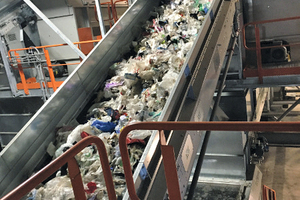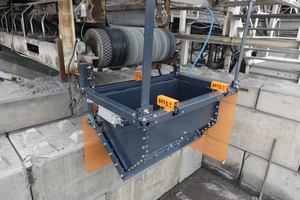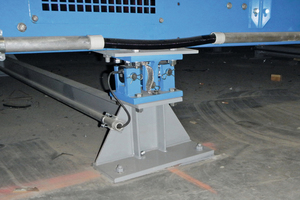Weighing technology in the waste management and recycling industry
Whether an existing plant or a new one is being built, operators and planners alike are faced with one question: at what point can material flows in recycling plants be recorded efficiently and accurately? The answer for many applications is: by means of weighing technology. Weighing is also the more accurate method compared to volumetric recording, since different bulk densities have no influence. There are various possibilities for recording the material flows in the respective processing stages, which are shown below.
Quantity recording on conveyor belts
Whether waste paper, yellow bag fraction or organic waste, whether wood waste or scrap metal - many of these materials run on conveyor belts before and after sorting, shredding and further processing. Built-in belt scales are ideal for recording quantities on the conveyor belts for several reasons.
Built-in belt scales are very robust and low-maintenance, making them ideal for use in this harsh industrial environment. Weighing is performed without additional effort during material conveying and reliably provides precise measurement results. The EBW 10 and EBW 20 series built-in belt scales are available in numerous variants: with one or two measuring idler stations, for belt widths from 400 mm to 2000 mm and conveying capacities from 2 t/h to 2000 t/h and more. Further advantages: The belt scales can also be retrofitted into existing conveyors and can be connected to the company‘s internal network via analog output or fieldbus interface. Requirements for the use of built-in belt scales are: the conveyor is equipped with a belt that is guided over roller idler stations, and there must be a material flow that generates a sufficient load on the load carrier.
Belt and apron conveyor weighing
If the conditions for installing a belt scale are not met, it should be investigated which alternatives are possible, e.g. belt weighing in which the conveyor system is completely supported on load cells.
A special feature is the weighing of pivoting apron conveyors, which are often used in metal recycling. The apron conveyors are mounted on one side on a chassis that can be supported on load cells. In these applications, high demands are placed on the load cell in terms of robustness and stability in order to be able to absorb the high torsional and horizontal forces occurring within the construction during chassis movement.
The extremely robust LMB 490 load cell is predestined for such heavy-duty applications. The load cell is firmly mounted without any horizontal or vertical movement. The LMB 490 can thus be used especially in mobile installations and generate dynamic belt weighing similar to a classic belt scale.
When it‘s too little for the belt scale
In the recycling sector, there is often also the task of recording material flows on conveyors of less than 2 t/h. This is a very difficult task. If the recycled material is then still very valuable, the weighing must also be very accurate. Here, conveyor discharge weigher offer a supplement to classic belt scales, when these cannot be used due to the low conveying quantities, the bulk material properties or the installation situation.
The conveyor discharge weigher type CDW is installed at the discharge point of a conveyor belt and collects the conveyed material in the hopper where it is weighed. This static weighing achieves a very high measuring accuracy of < +/- 1 %. The CDW is therefore often used for quantity measurement in the recyclables sector.
Weighing of bunkers and containers
Weighing is also often required for bunkers with discharge floors or for containers in which waste is stored by type. On the one hand, this is to record the quantities of these material groups, and on the other hand, to avoid overfilling of the bunker or container.
The VC 3500 and LCM 460 weighing modules are particularly suitable for weighing bunkers and containers. These modules are available with nominal loads from 2 t to 200 t and are extremely compact and robust. The special design of the module with a movable top plate ensures optimum force application even with slight inclination or lateral loads – completely without additional steering and lashing mechanisms, thus reliably ensuring accurate measurement results. The modules have an integrated lift-off protection and can be mounted directly between the bunker or container and its steel substructure. No dummies are required for installation. And another advantage: The load cell is mounted in the module in such a way that it can be replaced without removing the module.
Conclusion: weighing systems are also part of the basic equipment in the waste management and recycling industry, without which effective operation of a sorting and processing plant would no longer be possible. Weighing solutions are available for every process in the processing chain (collecting, sorting, processing, etc.).









